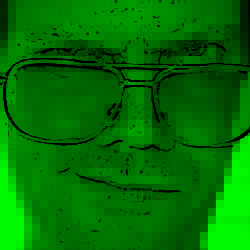A Munzee player gets a set of lat/long coordinates to search for. At those coordinates, no logbook lurks. Instead, there's something that a smartphone can scan. There are QR code Munzees: barcode stickers. There are NFC Munzees: shiny stickers that phones can detect wirelessly nearby. There are "virtual" Munzees: each just a set of lat/long coordinates. So the Munzee player scans a sticker (or something), the app double-checks GPS coordinates to make sure the player's really standing in the right spot.
One side effect of this phone-centric system is that I'll actually look for Munzees, whereas with geocaches I don't bother. (As with Geocaches, I'll look-for-the-closest-Munzee-I-haven't-visited-yet. But I'll actually try to find them, not just walk by.) A geocache might be a teeny-tiny little container, smaller than your pinky finger. It might be hidden under a rock. If there are a lot of little rocks around, good luck finding that cache. Since you need to hold your phone next to a Munzee to scan it, that Munzee's going to be less concealed, there's going to be some open space in front of it for folks to hold their phones. (Since that Munzee's not concealed, many have gone missing. But, whereas with a geocache you might spend a long time searching for that cache, thinking you might overlook it, with a Munzee I feel justified giving up relatively early.)
So unlike Geocaching, I'm not just walking from spot to spot; I'm actually playing the game. The bad news is that, while this does get me out from behind the computer for a while, it's not necessarily the best way to get in an excercise-walk.
I stand around fiddling with my phone. As I get close to the Munzee, I probably am looking at a map to get a better idea of what the Munzee's attached to. I scan the Munzee. I look to see where the next-closest Munzee is. When I'm not fiddling with my phone, I might be standing around holding a hand-mirror so I can look for a bar code sticker affixed to the underside of a railing.
Munzees tend to cluster together. I think that's because of how Munzee placement is "gamified." If you're a Munzee player, you get points for placing a new Munzee in the world—and more points whenever other players find your Munzee. Some Munzee players are more likely to search for a Munzee if it's placed close to other Munzees: if I take a morning to visit Lake Merced, I can find two Munzees; if I instead walk around the Palace of Fine Arts, I can find about a dozen, and earn many more points. So if someone's placing a Munzee and the put it in Lake Merced, a player might never make time to search for that Munzee. This morning, I "walked" around looking for Munzees, but most of the "walks" were only a half-block to a block long.
Maybe I shouldn't even list it among "over-engineered walks." I started doing this Munzee thing because as my find-the-nearest-unvisited-geocache sent me further and further away, I wanted a new set of coordinates to use. But instead, I've been straight-up playing the game, taking it as it is.
(Oh yeah: it thinks you should be within 300 feet of a sticker to be able to scan it. But GPS are squirrely enough that sometimes they think I'm further away than that. That's, like, half a block. Which suggests some interesting constraints on using, say, ClueKeeper's location-based functions for puzzles.)
